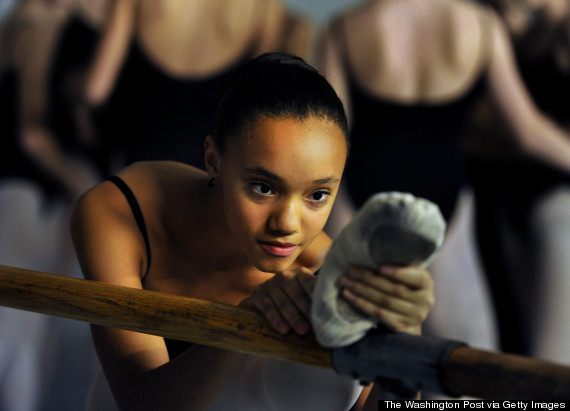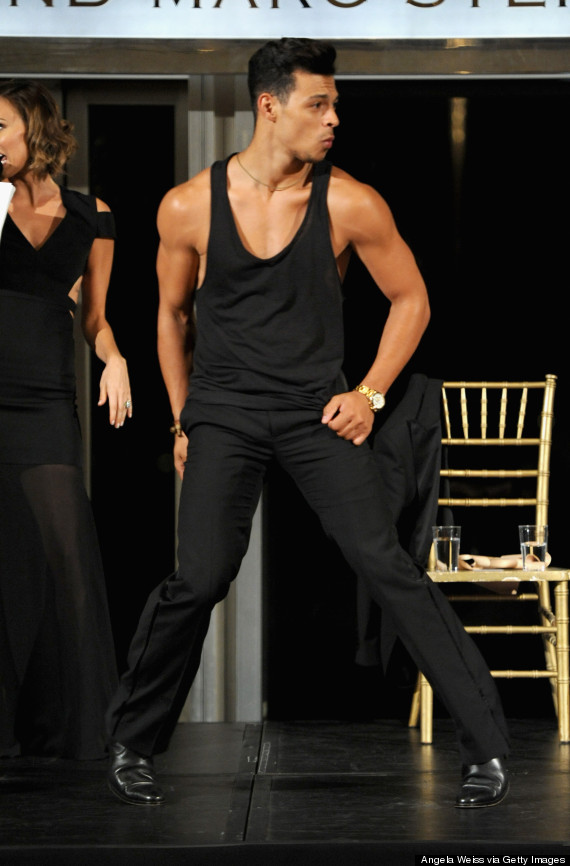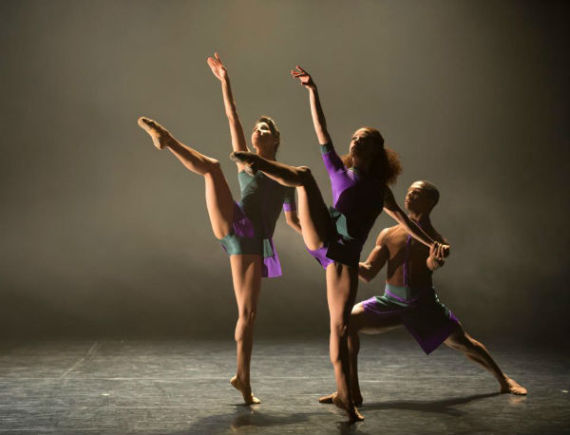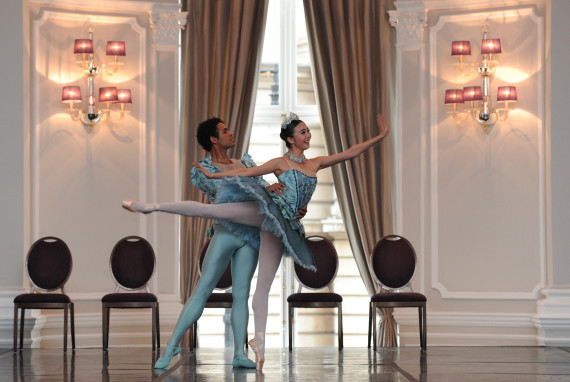Ballet has long suffered from a diversity problem. “Classical ballet celebrates pale princesses and fair swans,” Olivia Goldhill and Sarah Marsh wrote in The Guardian in 2012. “It’s a world where dancers cake their limbs in white powder, and where performers with darker skin don’t always feel welcome.”
“Ballet has a lily-white reputation,” Pointe Magazine reiterated this year.
Take one look at the dance landscape of the world’s most popular ballet companies and it’s not difficult to see that white men and women dominate the field. Before Misty Copeland, there hadn’t been a black soloist at the American Ballet Theater (ABT) for 20 years. Critics have taken notice, urging mainstream choreographers and directors to readdress their recruitment practices for black and Asian dancers.
Beyond race, ballet dancers have been held to tyrannical body standards. The sport is physically demanding to be sure, but the industry has had a reputation of favoring impossibly tall and thin figures over the muscular, athletic types. And retirement comes too early for most. “Dancers usually receive oblique indications that their time is up, like not being cast for roles they once danced or seeing younger dancers chosen in auditions,” Maroosha Muzafaar wrote in The Atlantic. “Most know that’s a sign to let go and move on to something else.”
While ballet has a long way to go in addressing these issues, there are plenty of dancers in the contemporary realm who are actively working to change the white-washed, body oppressive world of ballet. Behold, 17 ballet icons who are changing the face of dance:
1. Misty Copeland
Misty Copeland became the third African American female soloist at the American Ballet Theater back in 2007. Since then, she’s spoken openly about racism in the dance world. “[Ballet is] such a traditional and historic art form that people are afraid to change it,” she said in an interview with New York Magazine. “But I think it has to if it’s going to last in the world we live in today. It’s hard to change someone’s ideas when they might not even really consciously know that they’re being racist, or have racist ideas, just because ballet has been this way for hundreds of years.”
Her new Under Armor ad has been making waves online this week, effectively conveying a contemporary interpretation of what it means to be a ballerina.
2. Yuan Yuan Tan

Yuan Yuan Tan is a principal dancer with the San Francisco Ballet. In the late 1990s she became the youngest principal in the company’s history and the first Chinese dancer to be promoted to that level.
3. Shannon Harkins

Shannon Harkins was 13 years old when The Washington Post called her “the face of African American ballet dancers’ struggles.” At that time, she was the only African American girl at Level 7 at the Washington School of Ballet — the highest pre-professional level.
4. Kayla Rowser
Kayla Rowser is a company dancer at the Nashville Ballet who has spoken out about the importance of diversity — “diversity in body types, diversity in movement quality, diversity in all types of things” — in ballet. She was featured as one of Dance Magazine’s “Top 25 to Watch” last year and has worked with Project Plie, an ABT project aimed toward increasing racial and ethnic representation in ballet.
5. Desmond Richardson

Desmond Richardson is the co-founder and co-artistic director of Complexions Contemporary Ballet, a company that seeks to reinvent dance by creating an open environment that embraces multicultural forms of movement. Richardson also performed as a principal dancer at the Alvin Ailey American Dance Theater for seven years.
6. Natalia Osipova

While Natalia Osipova may look like the stereotypical image of a ballerina, her viewpoints express anything but. “I am not interested in sporting diamond tiaras on stage, or having my point shoes cooked and eaten by my fans,” she explained to The Spectator this year. “Ballet has evolved and the ballerina figure with it. The world around us offers new challenges, new stimuli and new opportunities, and I believe that it is the responsibility of every artist to be constantly ready to respond to these. There is simply no reason, nor time, to perpetuate century-old clichés, such as the remote, semi-divine figure of the 19th-century ballet star.”
Osipova’s attitude eschews the celebrity of a glamorous field, and we can’t help but love her progressive tone.
7. Chi Cao
You might remember Chi Cao from his acting debut in “Mao’s Last Dancer,” portraying dance star Li Cunxin. Like Li, Cao moved from his home in China to join a Western company, leaving his family behind to pursue a career in ballet. “We both went out to the West when we were very young. We had to face a lot of things, a lot of harsh realities when we were very young in a different society.”
Cao eventually became a principal dancer at the Birmingham Royal Ballet.
8. Chehon Wespi-Tschopp

Chehon Wespi-Tschopp became America’s Favorite Dancer back on “So You Think You Can Dance” Season 9. Being the first contestant to identify first and foremost as a ballet dancer, he brought the art form into the realm of mainstream television.
9. Evelyn Cisneros
Evelyn Cisneros is considered by many to be the first Hispanic prima ballerina in the U.S. A principal dancer at the Boston Ballet School, she has long been aware of her status as a Latina icon. “It was instilled in us at a young age that we were role models for our people. I carried that through my whole life,” she explained to NBC in 2012. “I always felt my Mexican heritage gave me a richer well to draw from, not the opposite.”
10. José Manuel Carreño

Born in Cuba, former ABT star José Manuel Carreño is the Artistic Director at the Ballet San Jose. After dancing as the Prince in “Swan Lake” as his final performance, he ventured from New York City to Northern California to lead the financially-troubled company.
11. Wendy Whelan

Wendy Whelan has become something of a figurehead for veteran dancers, advocating for financial support and career services for ballet icons nearing retirement. “We are not supported federally at all once we leave the ballet. There is no support whatsoever, financially or insurance wise for dancers in the United States.”
After 30 years at the New York City Ballet, the principal dancer will bid her adieu this October, with plans to continue dancing with the likes of Edward Watson and the folks at Manhattan’s City Center.
12. Aesha Ash
Aesha Ash left the New York City Ballet in 2003, back when she was the only black female dancer. She then started the Swan Dreams Project, a campaign that seeks to “change the demoralized, objectified and caricatured images of African-American women by exposing young ladies to the beauty of ballet.”
13. Cassa Pancho

Cassa Pancho is the founder of Ballet Black, a company devoted to inspiring opportunities for “dancers and students of black and Asian descent.”
“All through ballet school I was really aware of the lack of black people around me,” she explained to The Guardian. “So for my dissertation I thought I would interview black women working in ballet and see what they had to say –- but I couldn’t find a single black woman working in ballet, and that really stunned me. When I graduated, I decided, very naively, to do something about it myself.”
You can read more about Cira Robinson, Damien Johnson and Sayaka Ichikawa — all senior artists at Ballet Black — here. (Photo of the company by Bill Cooper.)
14. Carlos Acosta

Cuban-born Carlos Acosta, a principal guest artist at The Royal Ballet, has spoken openly about the lack of representation in ballet.
“The percentage of classical black ballet dancers around the world is sadly minimal, which is quite embarrassing,” Acosta has said. “In most companies, when a talented black dancer is chosen as a member, they don’t know how to cast them properly. Still, there is this mentality, especially with directors, that a black ballerina in the middle of a flock of white swans would somehow alter the harmony.”
15. Sylvie Guillem

Sylvie Guillem made a name for herself after leaving the Paris Opera Ballet to become an international freelance ballerina. Now in her late 40s, the woman bold enough to appear on the cover of French Vogue nude and without makeup (long before the makeup-free selfie craze) is happily bursting through barriers between the modern dance world and ballet with works like “6000 Miles Away.“
16. Shiori Kase

Tokyo-born Shiori Kase is a soloist with the English National Ballet who recently wowed critics in the London staging of the “psycho-thriller” ballet, “Coppélia.”
17. Michaela DePrince

Sierra Leone-born Michaela DePrince spent her early years in an orphanage after her father was killed during the civil war in her country. After being adopted by an American family and entering the world of ballet, she was told at the age of eight that America wasn’t “ready for a black girl ballerina.” Despite her challenging childhood, she’s gone on to win a position in ABT’s preprofessional division and the Dutch National Junior Company.






